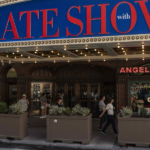As the Fed moved forward with plans to renovate its Great Depression-era headquarters in Washington during Trump’s first term, it faced concerns in 2020 during a vetting process involving Trump appointees, who called for more “white Georgia marble” for the facade of the building.
The Fed’s architects said the central bank wanted glass walls, to reflect the Fed as a transparent institution, but three Trump appointees to a local commission felt marble best fit the building’s historic character. While most of the proposed glass exterior was kept, some marble was added as a result, according to the minutes of the Commission of Fine Arts, which advises the federal government on architecture.
The marble does not explain the roughly $600 million in cost overruns for the project, now budgeted to cost $2.5 billion, which also includes the addition of an underground parking garage and new glass atria in the building’s courtyards. But the roots of its extensive use further muddies the White House’s attempts to use the renovation to paint the central banker as a profligate spender as a possible pretext to removing him.
“I wouldn’t be surprised if the result costs more” because of the added marble, said Alex Krieger, a Harvard University emeritus professor who was a member of the commission and participated in hearings on the Fed’s proposal.
The National Capital Planning Commission, which also reviewed and approved the Fed renovation project, has started an inquiry into how Powell oversaw the updates.
“The Federal Reserve’s extravagant multi-billion dollar renovation happened on the watch of the Fed’s leadership, and the Fed’s leadership needs to own up for this mismanagement of taxpayer dollars – as well as its botched coverup job,” said White House spokesman Kush Desai. A Fed spokesperson declined to comment.
James Blair, a White House deputy chief of staff who was recently added to the planning commission, said Wednesday that he would send a letter to the Fed requesting any revisions to the project. His goal is to see whether Powell was accurate in his congressional testimony.
“He’s either telling the truth or he isn’t,” Blair told The Associated Press. “If he’s telling the truth, he can prove it by just submitting all the plans and revisions.”
Blair told reporters Friday that the Fed offered to let them inspect the construction site at 7 p.m. that evening, but the timing didn’t work and officials would like to tour the area next week.
Trump said Wednesday that he’s “highly unlikely” to try to fire Powell unless there was what he deemed as “fraud.”
The 115-year old Commission of Fine Arts reviewed the plans for the renovation three times in 2020.
Stroik “does not think the proposed additions defer to the historic buildings as great marble edifices on an important street,” the minutes added.
Stroik’s amendment was voted down, but the commission didn’t fully endorse the Fed’s plans. The architects presented new plans in May 2020, though those didn’t appear to satisfy Trump’s appointees.
Stroik, now a professor of architecture at the University of Notre Dame, said in an interview that “stone buildings don’t necessarily have to cost a fortune.” But he acknowledged that the commission had not discussed expenses, which has not been part of its mission.
“If they wanted to play the cost game, you do a marble facade and you do the glass facade and you compare the cost,” Stroik said. “And you know, they never did that.”
“At the time, it was a fierce battle over how literal to the original design should the renovations be,” Krieger said. “Normally, that attitude does add costs to the construction project.” McCrery declined to comment.
The commission did not fully approve the Fed’s project until September 2021, after McCrery and another Trump appointee, Justin Shubow, had been removed by then President Joe Biden.









